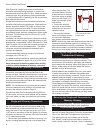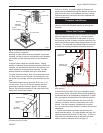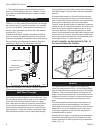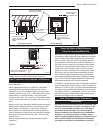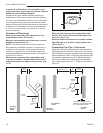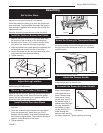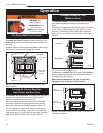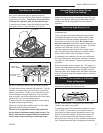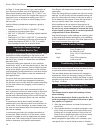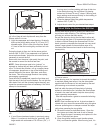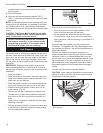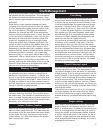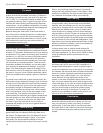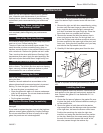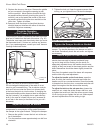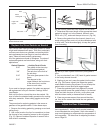
14
Encore Multi-Fuel Heater
2000971
on Page 17 to see how the size, type, and location of
your chimney will affect your stove operation. When
thermometer readings drop below 175° C (350° F) it’s
time to adjust the air control for a higher burn rate or to
reload the stove. A temperature reading over 385° C
(750° F) is a sign to cut back on the air supply to slow
the burn rate.
Use the following temperature ranges as a guide to
operation:
• Readings in the 175°-260° C (350-500° F) range
indicate low to medium heat output.
• 260°-315° C (500-600° F) readings indicate medium
heat output.
• Readings of 315°-400° C (600-750° F) indicate high
heat output. Operating your Encore continuously at
griddle temperatures of 385° C (750° F) or higher
may damage the cast iron or enamel finish.
Use the Air Control Settings
that Work Best for You
No single air control setting will fit every situation. Each
installation will differ depending on the quality of the
fuel, the amount of heat desired, and how long you wish
the fire to burn; outdoor air temperature and pressure
also affect draft.
The control setting also depends on your particular
installation’s “draft,” or the force that moves air from the
stove up through the chimney. Draft is affected by such
things as the length, type, and location of the chimney,
local geography, nearby obstructions, and other factors.
Refer to Page 23 for details on how the installation af-
fects performance.
Too much draft may cause excessive temperatures in
the Encore, and could even damage the combustor.
On the other hand, too little draft can cause backpuffing
into the room and/or the “plugging” of the chimney or
combustor.
How do you know if your draft is excessively high or
low? Symptoms of too much draft include an uncontrol-
lable burn or a glowing-red stove part. A sign of inad-
equate draft is smoke leaking into the room through the
stove or chimney connector joints, low heat, and dirty
glass.
In some newer homes that are well-insulated and
weather-tight, poor draft may result from insufficient air
in the house. In such instances, an open window near
the stove on the windward side of the house will provide
the fresh air needed.
In some areas provisions for outside combustion air
are required. Refer to section 2 of Document J which
requires an outside air vent for appliances with power
outputs over 5 kW. Always refer to national and local
codes to determine your specific requirements.
Your Encore will accept a duct to deliver outside air for
combustion.
When first using the stove, keep track of the air control
settings. You will quickly find that a specific setting will
give you a fixed amount of heat. It may take a week or
two to determine the amount of heat and the length of
burn you should expect from various settings.
Most installations do not require a large amount of
combustion air, especially if adequate draft is available.
Do not for any reason attempt to increase the firing
of your heater by altering the air control adjustment
range outlined in these directions.
Use the following air control settings as a starting point
to help determine the best settings for your installation.
Each is described as a fraction of the total distance the
lever may be moved from right to left.
Encore Control Settings
Burn Rate Primary Air Control
Low From far right to 1/3
the distance to left
Medium From 1/3 to 2/3 the distance
to left
High From 2/3 the distance
to left to far left
Conditioning Your Stove
Cast iron is extremely strong, but it can be broken with
a sharp blow from a hammer or from the thermal shock
of rapid and extreme temperature change.
The cast plates expand and contract with changes in
temperature. When you first begin using your Encore,
minimize thermal stress by allowing the plates to adjust
gradually during three or four initial break-in fires follow-
ing Steps 1-3 below.
Starting and Maintaining a Fire
Burn wood or coal directly on the grate. Do not elevate
the fuel.
The damper must be open when starting a fire or
when refueling.
Do not use chemicals or fluids to start the fire. Do
not burn garbage or flammable fluids such as gaso-
line, naptha, or engine oil.
1. Open the stove damper, and open the primary air
control fully.
2. Place several sheets of crumpled newspaper in the
stove. Place on the paper six or eight pieces of dry
kindling split to a finger-width size, and on the kin-
dling lay two or three larger sticks of split dry wood
approximately 25-51 mm (1-2”) in diameter.
Never use gasoline-type lantern fuel, kerosene, char-
coal lighter fluid, or similar liquids to start or “freshen



